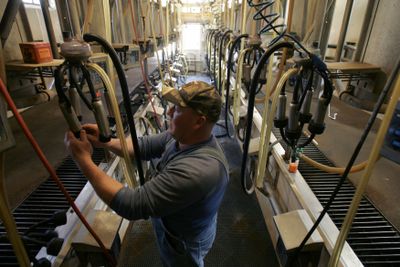Milk glut puts squeeze on dairies
Plunging prices have many farmers on edge of bankruptcy

BARNHART, Mo. – A collapse in milk prices has wiped away the profits of dairy farmers, driving many out of business while forcing others to slaughter their herds or dump milk on the ground in protest. But nine months after prices began tumbling on the farm, consumers aren’t seeing the full benefits of the crash at the checkout counter.
The average price for a gallon of milk at grocery stores last month is down just 19 percent from its peak of $3.83 in July. Farmers, on the other hand, got $1.04 a gallon in April – 35 percent less than they were paid last fall. This winter, wholesale prices were down as much as 45 percent.
The price that farmers get has been wildly volatile for years, creating a succession of booms and busts felt from pastures to the grocery store. Today, frustrations are spilling over as the price crash creates widely divergent fortunes within the milk industry, boosting profits for the middlemen like dairy processors while pushing farmers to the edge of bankruptcy.
Last fall and summer, milk processors and supermarkets swallowed losses because of high wholesale milk prices and government-mandated ceilings on what they can charge. They’re now recouping some of what they lost and anticipating a rise in prices this winter, said Mike Nosewicz, vice president of dairy operations at Cincinnati-based Kroger Co., which operates its own dairy processing division and sells milk through 2,400 supermarkets.
At the heart of the problem is the nature of milk. Unlike grain farmers who can hold out for better prices by storing crops in a silo, dairymen must sell raw milk to processors or else it spoils. And cows keep producing whether the economy’s expanding or in recession.
The price paid by processors to farmers is set by the U.S. Department of Agriculture based on commodity markets, which rise and fall with global demand. Some of the raw milk is processed into milk for stores as well as butter, yogurt and other products. The rest becomes powdered milk, cheese and whey for international and domestic markets.
U.S. milk exports soared last year and demand grew in countries like China while supplies dropped from Europe and Australia. Wholesale prices jumped. Dairies responded to the demand by increasing production. But once the recession accelerated last fall, demand fell off a cliff.
U.S. farmers were suddenly faced with too much milk and too many cows. Wholesale prices crashed. Farmers found themselves spending more to maintain their herds than they were being paid for raw milk.